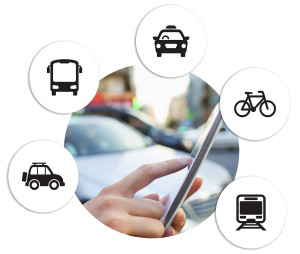Currently, many in Sweden are getting their driving licences later in life and interest in car ownership is waning. Mobility services that combine multiple types of transport to make daily trips could consequently expand in scope. Presenters at Transportforum shared their visions and experiences.
The Ubigo service was a pilot project carried out in 2013–2014. The project tested a business model and cooperation between various operators and actors. In the project, 70 Gothenburg households subscribed to use public transport, rental cars, carpools, taxis, and bicycles via an app to make their daily trips. The users estimated their monthly needs for the various modes of transport, and then accessed them using a digital punch card in the app. Each month they received a combined invoice for their subscription plus any additional purchases. Upon evaluation, the service received very high marks: it was simple, good value for the money, and opened up new travel possibilities.
“We have to demonstrate that it is viable to make money on this for it to be possible to continue using it in the future”, says Hans Arby at Ubigo Innovation. He suggests that there are major financial benefits to offering combined mobility with the right business model.
The pilot project has been completed, and the next phase is to get the service running permanently in 2016 with most of the same actors as before, with Ericsson now supplying the IT platform.
Why now?
Why is this concept now gaining traction in Sweden? Such mobility services, referred to in the industry as Mobility as a Service (MaaS) bundles, entail using multiple modes of transport. However, they often provide added value in the form of customer service, support, and flexibility for users. Christer Ljungberg from consulting firm Trivector emphasises that Swedish lifestyles and attitudes could enable more mobility services to supplant the dominant role of the automobile in the transport system of the future.
“We are one of the world’s most modern countries, and we like new things”, says Ljungberg.
In addition to that factor, urbanisation is advancing in Sweden: multiple parallel lifestyles coexist, many people are striving for sustainable lifestyles, and car ownership is no longer as important for many of those living in major urban areas. The technology for providing various MaaS services already exists; it is the services that have to find an attractive form in order to lure a broader public.
Finland commits globally
Sampo Hietanen of ITS Finland reports having very ambitious goals for his new company, which will start operating mobility services on the global market in 2016.
“It’s time to get a divorce from the car and marry MaaS”, says Hietanen.
However, he confirms that no single entity can solve the problem of creating MaaS services. An entire cluster of functions has to be in place: laws, technical conditions and assumptions, financiers, and other enabling factors. One positive circumstance in Europe is the ability to derive benefit from its highly developed public transport system.
“One threat is that we will not succeed in bringing the different actors together, in which case we will be out-competed by the self-driving cars of tomorrow. Just like today’s cars, they will take up massive amounts of space in our cities”, he says.
This article is a report from the VTI conference Transportforum 2016. You find more information about the conference here (in Swedish).







Follow us: